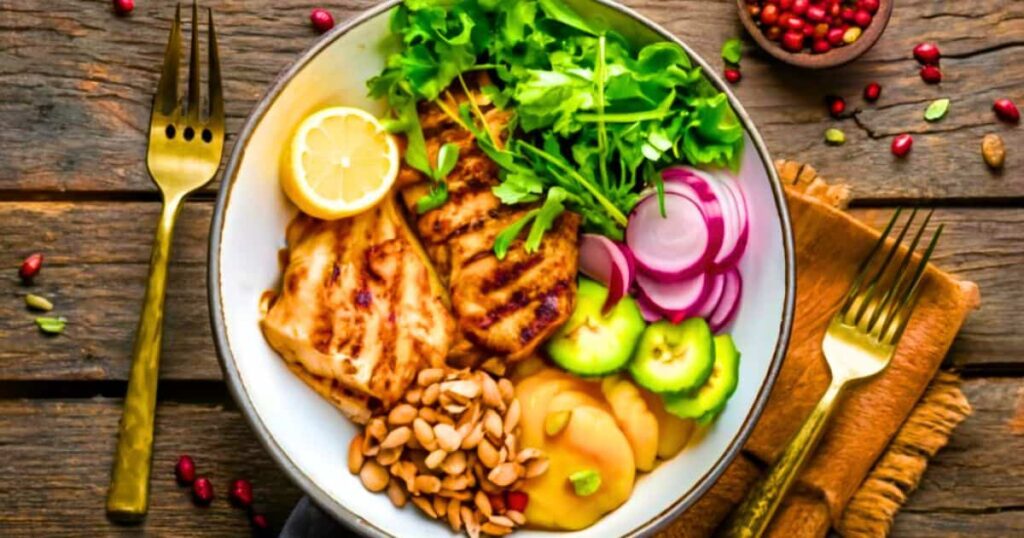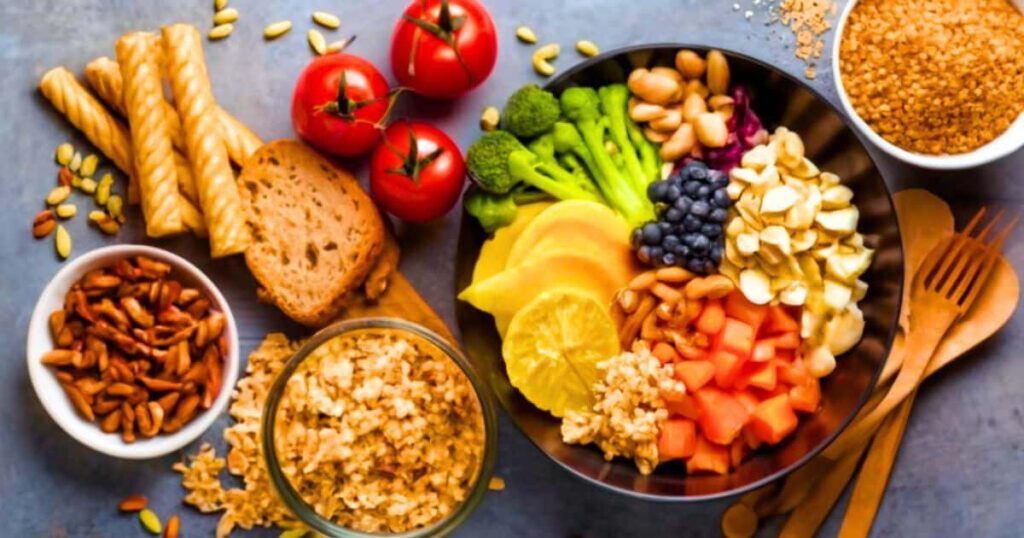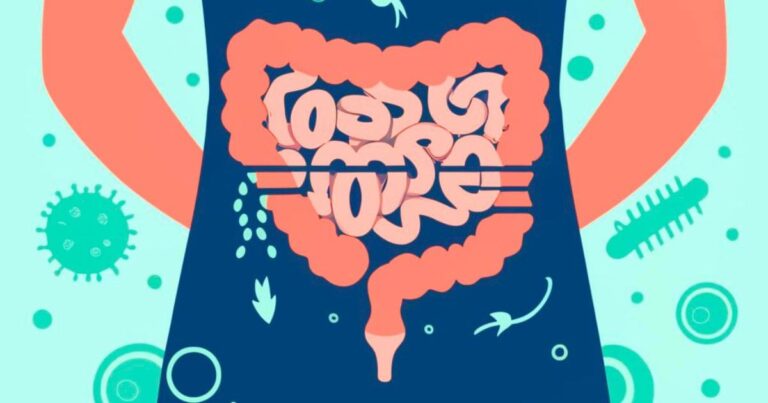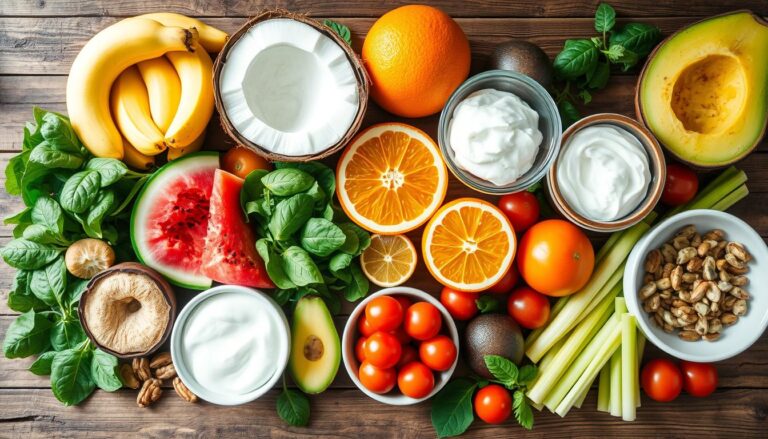A slim, toned physique that also has sculpted muscle is the holy grail of fitness for many individuals. Nevertheless finding this balance might appear contradictory.
A calorie deficit is essential to burn fat, while a calorie surplus is frequently necessary to develop muscle.
How can you therefore, fulfill both goals at once? One effective strategy is to focus on strength training exercises that target multiple muscle groups, such as squats, deadlifts, and bench presses.
These compound movements not only build muscle but also help burn calories. Additionally incorporating high intensity interval training HIIT into your workout routine can boost your metabolism and promote fat loss while preserving muscle mass.
By combining these approaches with a balanced diet rich in protein, carbohydrates, and healthy fats, you can achieve the elusive balance of a lean, muscular physique.

The notion of body recomposition contains the key
During this process, you will learn to actively adjust your eating habits and exercise routine in order to stimulate muscle building and reduce excess fat. You may have the physique you’ve always wanted with hard work and the perfect technique, but it won’t happen overnight.
Consistency is key when it comes to achieving your desired results. It’s important to stay committed to your fitness goals and not get discouraged if progress is slow. Remember that building muscle and losing fat takes time and dedication, but the results will be worth it in the end.
Keep pushing yourself and you will eventually see the changes you’ve been working towards.
To aid you on your way to body recomposition, this article discusses six crucial tactics:
1. Fuel Your Workouts with a Strategic Diet:
The essential elements are required for muscular development they do not spontaneously emerge. Your diet plays a crucial role in providing the required nutrients your body needs to repair and rebuild muscle tissue after a rigorous activity. Here are the dietary basics of body recomposition:
Prioritize Protein:
Protein is the cornerstone of muscle. Aim for 0.8–1 gram of protein per pound of body weight daily. Lean protein sources like chicken, fish, beans, and lentils should be staples in your diet.
These foods not only help repair and build muscle, but they also keep you feeling full and satisfied.
In addition to protein, make sure to incorporate a variety of fruits, vegetables, whole grains, and healthy fats into your meals to ensure you are getting all the necessary nutrients for optimal muscle growth and overall health. Remember that proper hydration is also key in supporting muscle function and recovery.
Don’t Fear Carbs:

Carbs supply the energy your body needs to push through your routines. Focus on complex carbohydrates like whole grains fruits, and veggies. These give lasting energy and important vitamins and minerals.
Avoid simple carbohydrates like white bread and sugary snacks, as they can cause a quick spike in energy followed by a crash.
By incorporating a variety of complex carbs into your diet you can sustain your energy levels throughout the day and fuel your workouts effectively. Don’t forget to also include protein and healthy fats in your meals for a well-rounded and balanced diet.
Healthy fats are your friends.
Healthy fats, like those found in nuts, seeds, avocados, and olive oil, are crucial for hormone balance, satiety, and nutrient absorption. Include them in moderation throughout the day.
These healthy fats can also help reduce inflammation in the body and support brain function. Be sure to choose unsaturated fats over saturated fats whenever possible to promote heart health. Incorporating a variety of sources of healthy fats into your diet can help you feel more satisfied after meals and maintain overall wellness.
Micronutrients Matter:
Don’t underestimate the potency of vitamins and minerals. They perform a critical function in various biological operations, including muscle regeneration and metabolism.
Ensure a balanced diet rich in fruits, vegetables, and whole grains to meet your micronutrient requirements. A deficiency in vitamins and minerals can lead to serious health issues, so it’s important to pay attention to what you’re putting into your body.
Supplements can also be helpful in ensuring you’re getting all the nutrients you need, but it’s best to get them from whole foods whenever possible. Remember, a well-rounded diet not only benefits your physical health but also your mental well-being.
2. Embrace Strength Training:

Strength training is the cornerstone of gaining muscle. Here are some key aspects to consider:
Compound lifts are king.
Focus on complicated routines that target several muscle groups at once. Examples include squats, deadlifts, bench presses rows, and overhead presses. These exercises stimulate great muscle growth and boost your overall calorie expenditure.
Incorporating these compound exercises into your workout routine can help you reach your fitness goals more efficiently by targeting multiple muscle groups simultaneously.
By engaging in these complex movements, you can build strength, improve your balance, and enhance your overall physical performance. Additionally these exercises can help prevent muscle imbalances and reduce the risk of injury by promoting functional strength throughout your body.
Progressive Overload:
To keep challenging your muscles and stimulating growth progressively increase the weight, sets, or repetitions over time.
This ensures your body continues to adapt and build strength. Increasing the intensity of your workouts also prevents plateaus and helps you avoid getting stuck in a rut.
By gradually pushing your limits, you will see continued progress and improvements in your overall fitness. Remember to listen to your body and make sure to rest and recover to prevent injury and keep your muscles healthy.
Proper Form is Paramount:
Using optimal form is crucial to reducing damage and promoting muscle activation. Consider working with a qualified trainer to perfect your technique, especially for intricate exercises.
Proper form not only helps prevent injuries but also ensures that you are targeting the right muscles effectively.
A trainer can provide personalized feedback and adjustments to help you achieve your fitness goals safely and efficiently. Don’t be afraid to ask questions and seek guidance to make the most out of your workouts.
3. HIIT for fat loss and muscle retention:
High-Intensity Interval Training HIIT is a time-efficient way to boost your metabolism and burn calories.
Brief bursts of intense activity followed by brief rest periods offer an afterburn effect, enhancing your calorie expenditure even after your exercise is complete. However, HIIT may be harsh on your body. Limit HIIT exercise to 2-3 times per week and provide adequate rest for the best muscle recovery.
4. Prioritize sleep for muscle repair and recovery.

Sleep is not a luxury it’s necessary for muscle growth. During sleep, your body releases growth hormone, a crucial factor in muscle repair and regeneration. Aim for 7-8 hours of quality sleep each night to boost your body’s potential to build muscle and burn fat.
Not getting enough sleep can lead to decreased muscle mass and a slower metabolism, making it more difficult to achieve your fitness goals.
In addition to adequate sleep, maintaining a balanced diet and staying hydrated are also important factors in supporting muscle growth and fat loss. Prioritizing rest and recovery is essential for overall health and well-being, so make sure to make sleep a priority in your fitness routine.
5. Listen to your body and manage stress.
Overtraining and continual stress could impair your results. It’s vital to attend to your body’s signs and integrate rest days into your plan. Additionally, manage stress levels using relaxation methods like yoga, meditation, or spending time in nature.
Chronically high stress hormones could lead to muscle injury and impede fat removal. Listen to your body and give it the rest and relaxation it needs to recover properly.
Ignoring the signs of overtraining and stress could ultimately set you back in achieving your fitness goals. Remember, taking care of your physical and mental well-being is just as important as staying consistent with your workouts.
6. Consistency is key.
Body recomposition is a marathon, not a sprint. Be patient and diligent with your diet and training strategy. Don’t be dismayed by delayed improvement modest continuous modifications lead to lasting consequences.
Remember progress takes time and consistency is key. Celebrate small victories along the way and focus on the long-term goal of achieving a healthier and stronger body. Stay dedicated and trust the process, and you will see the results you desire. Remember, slow progress is still progress.
Conclusion:
Building muscle while losing fat takes a structured technique. By combining a balanced diet rich in protein with a well-structured strength training program, employing HIIT sensibly, prioritizing sleep, and reducing stress, you may acquire the sculpted figure you desire. Remember, consistency is essential.
Stay dedicated to your goal, monitor your progress, and celebrate your successes. Gradually, you’ll find your body evolving into its strongest and most confident self.
FAQs:
Can I grow muscle in a calorie deficit?
While gaining big muscle is easier with a small calorie surplus, some muscle growth may occur with a deficit. The goal here is to prevent muscle loss while prioritizing fat reduction.
By maintaining a high protein intake and engaging in resistance training exercises, individuals can help preserve muscle mass even while in a caloric deficit. It’s important to pay attention to how the body responds to this deficit and adjust accordingly to ensure that muscle loss is minimized.
Additionally adequate rest and recovery are essential to support muscle growth and repair during periods of caloric restriction.
How much cardio should I do for body recomposition?
Focus on strength training as the key driver of muscle growth. You may combine moderate-intensity cardio 2-3 times per week for 20–30 minutes per session.
Prioritize activities you enjoy, such as brisk walking, swimming, or cycling. Remember, consistency is key when it comes to seeing results in your fitness journey.
Incorporating strength training into your routine will help increase muscle mass and boost your metabolism. Don’t forget to fuel your body with nutritious foods to support your workouts and aid in muscle recovery. Keep pushing yourself and staying dedicated to your fitness goals!
Are there any supplements that may assist with body recomposition?
Protein powder may be a helpful solution to meet your daily protein needs. Creatine may provide some benefits for strength and muscle growth. However, a balanced diet should be your principal priority. Consult a doctor before taking any supplements.
What if I don’t receive results immediately?
Body recomposition demands time and attention. Track your progress with body measurements, strength gains, and how your apparel fits. Celebrate little wins and maintain motivation for the long haul. Remember, progress may not always be linear, so don’t get discouraged if you hit a plateau.
Stay consistent with your workouts and nutrition, and trust the process. Keep pushing yourself to reach your goals, and remember that every small victory is a step in the right direction. Stay focused, stay positive, and keep working towards a healthier, stronger you.
Should I entirely remove certain foods?
Restrictive diets are often unsustainable and may lead to food deficiencies. Focus on moderation and a balanced approach with a selection of nutritional foods.
This can help ensure that you are getting all the necessary nutrients your body needs to function properly.
It’s important to listen to your body and eat intuitively, rather than following strict rules or restrictions. By incorporating a variety of foods into your diet, you can enjoy a wide range of nutrients and flavors while still maintaining a healthy lifestyle. Remember, it’s all about balance and finding what works best for you and your individual needs.
Additional Tips:
Stay Hydrated: Drinking sufficient water is crucial for overall health and muscle function. Aim for 2-3 liters of water daily, changing based on your activity level and location.
Track your progress: Monitoring your progress helps you stay motivated and change your strategy as appropriate. Track body measurements, strength gains, and how your garments fit.
Find a workout buddy. Having a workout buddy may boost accountability and make training more pleasurable.
Enjoy the process: Focus on the fantastic modifications you’re making to your health and well-being. Celebrate your victories and enjoy the journey of developing a better, healthier self.
Remember: This page offers general information. It’s suggested that you see a healthcare professional or experienced nutritionist for specific advice on your body recomposition journey. They may help you build a plan geared to your specific needs and goals.





